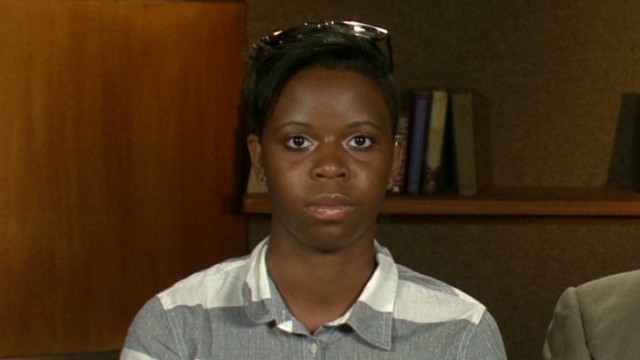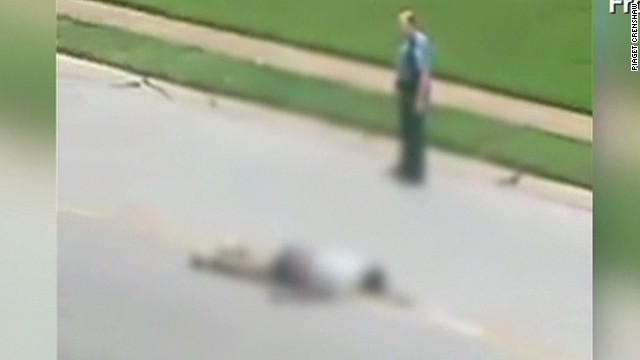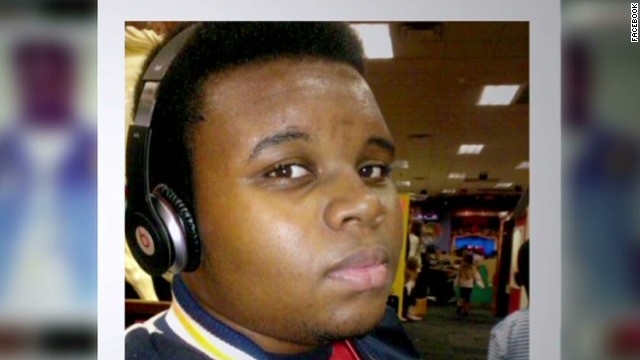Story highlights
- "Hands up, don't shoot" has become a symbol of police mistreatment of minorities
- Witnesses have said Michael Brown's hands were up when he was shot
- Physical evidence inconsistent with him having his hands raised when he was shot in the arm
(CNN)The forensic pathologist hired by Michael Brown's family called it "the controversial one" -- the bullet that passed through Brown's right forearm, shattering parts of his bones and leaving a gaping exit wound.
Those following the case hoped it would explain a key question in Brown's death: Were his arms raised in surrender when Ferguson police Officer Darren Wilson shot him, as some witnesses said?
Or would the evidence corroborate Wilson's version of events: that Brown charged him with his left hand balled in a fist and his right in the waistband of his shorts, even as the officer ordered him to stop?
The answer could explain whether Wilson had reason to fear for his life when he shot the unarmed 18-year-old, or whether he used excessive force.
Before a grand jury convened in the case, protesters and activists seized upon the idea of a young black man raising his arms in surrender, transforming it into a protest symbol that persists today. After a grand jury declined to indict Wilson, in rallies and demonstrations the phrase came to symbolize something larger than what transpired in the Michael Brown case.
"Hands up, don't shoot" has become shorthand for police mistreatment of minorities, one that's spreading beyond traditional protest scenes. It has evolved into a national movement with demands centered on changing what some see as systemic problems in law enforcement that lead to mistreatment of minorities.
Protesters, pro athletes, Broadway performers and congressional staffers have used the gesture in public in a show of solidarity. Last month, when nine police officers walked into a Mexican restaurant in Brooklyn, an employee raised his hands in an apparent protest of the police, the restaurant said; the officers left.
"It's a universal symbol of surrender. It's also a very simple gesture, and that's part of what makes something resonate," said Jane Rhodes, head of African-American Studies at the University of Illinois at Chicago.
A review of thousands of pages of grand jury documents, however, does not definitively support the conclusion that Brown had his hands raised above his head when he sustained the "controversial" gunshot wound in the arm. In fact, the physical evidence does not provide a clear picture of what happened. It is open to interpretation, leaving a wide range of possibilities.
What the witnesses said
Some facts in this case are undisputed.
Around 11:30 a.m. on August 9, Wilson encountered Brown and Dorian Johnson as they walked down the middle of Canfield Drive in Ferguson, Missouri, near St. Louis. Brown soon lay dead, face-down in the street after Wilson shot him multiple times. His left arm was under his body, and his right arm was slightly out to the side.
The gunshots drew the attention of dozens of residents of Canfield Green Apartments, a complex of mostly low-rise brick apartment buildings set off from Canfield Drive by grass lawns and sidewalks. They watched parts of the incident from living rooms, bedrooms and balconies. Motorists and construction workers at street level also stopped to observe.
After the gunshots ceased, crowds gathered on the sidewalk, discussing what happened. Within hours, some accounts spread through social media and became national headlines.
Tiffany Mitchell, who was picking up a co-worker at Canfield Green that morning, offered one of the earliest firsthand accounts claiming Brown had his hands up.
Mitchell's co-worker, Canfield resident Piaget Crenshaw, came forward with video showing Brown's body lying in the street, stirring anger and raising questions about why his body lay there for hours.
The grand jury watched some of these interviews. They also heard from dozens of witnesses who claimed to see parts of the shooting, though the credibility of some fell apart on the stand.
Some witnesses said Wilson exited his police SUV and drew his gun on Brown as he tried to flee. They gave divergent accounts as to when Wilson began shooting and the location of Brown's hands after he turned to face Wilson.
For example, a family of three adults, who watched the encounter from a second-floor porch facing Canfield Drive, had different recollections.
The first of the three witnesses to appear before the grand jury said that as Brown turned to face Wilson, he raised his hands up to his shoulders, palms facing the officer.
"They were shoulder high, they weren't above his head, but he did have them up," the witness testified.
Brown took a few steps forward and Wilson shot him, the witness said. He kept shooting as Brown staggered forward and fell to the ground.
The second witness said Brown had "his hands up to his sides," palms facing forward, as he stepped toward Wilson.
The third witness demonstrated the position of Brown's arms to the grand jury, agreeing with prosecutor's description: "fingers pointed toward the ground," palms facing forward, "arms slightly bent at the elbows, but to his side."
"He didn't have his hands up fist ball or anything of that nature," the witness said.
As for words exchanged between Brown and Wilson, one witness who initially told law enforcement that Brown said "don't shoot" later recanted. Two construction workers who said they watched the shooting from roughly 50 to 60 yards away testified that Brown raised his hands high above his head and shouted "OK, OK," as if to surrender. A cell phone video from the scene capturing their immediate reaction to Brown's shooting went viral, bolstering accounts that he had his hands up at some point during the shooting.
Some witnesses supported parts of Wilson's account. A construction worker said with certainty that Brown "never put his hands up" and that Brown "ran towards the officer full charge," even after being shot.
Another witness sitting in the second row of a stopped car on Canfield Drive also said Brown "charged" at Wilson, despite being told to stop "at least three times." Brown put his hands in the air, "balled up in fists" like he's "running with his hands close to his chest," before Wilson fired four rounds, the witness said.
In cases with inconsistent testimony, video is arguably the best evidence if it can be pieced together to cover all or most of the event, said Beth Karas, a former Manhattan prosecutor.
The jury saw clips of witness testimony, but no known video of Brown's shooting exists.
"Physical evidence that is consistent with the eyewitness's description of the event bolsters the credibility of the witness," Karas said. "But if the witness's account differs from the forensics, then science trumps the witness."
What the physical evidence said
The "controversial" gunshot to the forearm was one of three to Brown's right arm, according to autopsy reports and forensic testimony. It raised questions about where Brown's arms were during the encounter.
That shot entered the hairy side of Brown's forearm through his ulna bone -- the bone that lines up with the pinky finger -- and exited through the other side, forensic pathologist Dr. Michael Baden told the grand jury.
Baden's findings were consistent with those from postmortem exams by the St. Louis County Medical Examiner's Office and the U.S. Department of Defense, which participated at the request of the St. Louis County Prosecuting Attorney's office.
Baden offered two theories as to where Brown was standing when the bullet struck.
"This supports being shot from behind. It didn't hit his back, but from behind," Baden said.
Or, because arms rotate on various axes, the injury also could have occurred if Brown's hands were raised in front of him, palms facing his body, he said.
"I'm saying at the time of the shooting the gun was pointed at the back of his arm, that's all," Baden said. "Where his arm was depends on what other information you have."
The other medical examiners said there is no way to determine the position of Brown's body when he suffered the forearm injury.
"Our arms can do all sorts of things in three-dimensional space," testified the military pathologist. "It's difficult, but I think there is a lot of different scenarios that can explain that trajectory."
To figure out where Brown's arms were requires looking at the evidence in its totality, from ballistics to crime scene photos, defense lawyer and CNN legal analyst Mark O'Mara said.
As for the position of his hands when he was shot, the theory most consistent with crime scene and forensic evidence suggests that Brown's hands were in front of him when he was shot in the arm, but probably no higher than his shoulders, O'Mara said.
That does not mean he never raised his hands -- just that bullets did not strike his arms when they were raised, he said.
"What would conclusively give us hands up would be if he had a bullet wound in his palm, but he doesn't," he said. "It seems that his hands were raised in front of him but not over his head."
Why 'hands up' still resonates
To people who have embraced the "hands up" gesture, though, the varying accounts don't seem to matter much. Within hours of the shooting, "hands up" became a rallying cry, a social media meme and a T-shirt slogan.
It has become a powerful protest symbol. And symbols can be persuasive. History is full of them.
The American Revolution had "no taxation without representation" and a famous engraving of the Boston Massacre. Civil rights marchers sang "We Shall Overcome." And two black U.S. athletes provided an iconic moment by raising their fists on the winner's podium at the 1968 Summer Olympics.
"Hands up" took off because it's a reality for many people of color, activist and organizer DeRay Mckesson said. People don't need a national advocacy group or a charismatic leader to explain it to them. People relate to it on a personal level.
"When we say 'hands up,' it's about reminding police we are unarmed and reminding them of a pattern of police brutality," he said.
The image has transcended the specifics of Ferguson to make a longstanding grievance a national issue. It started a conversation about racial politics and allegations of police misconduct that continued with police-related deaths of Eric Garner in New York and Tamir Rice in Ohio.
Symbols and slogans also buoyed protests related to those deaths. Demonstrators invoked the phrases, "I can't breathe" and "black lives matter," the latter of which has steered the national conversation from Ferguson to broader concerns about police brutality and racial bias in the justice system, Mckesson said.
Those slogans and symbols work because they are easy to understand, said Rhodes, the University of Illinois history professor. If a symbol lends itself to multiple interpretations, it won't unite people around a common goal or theme, she said.
"You want a universal symbol, or as universal as possible," she said.
People tend to make the strongest symbols, especially if they are sympathetic or could be considered a victim, said sociologist James M. Jasper, author of "The Art of Moral Protest."
"You want a person you can identify with, a normal person you don't think of as deviant or superhuman either," said Jasper, a professor at the Graduate Center of the City College of New York.
"If they're too strong and autonomous, they can take care of themselves, then they don't need you to help them."
"Hands up" has a narrow meaning compared with the universality of "black lives matter," Jasper said. But it's more effective as a protest symbol because it gives people two things to do: chant and gesture.
"You want to engage people in a march, and chanting is a good way to do it," he said. "But if you give them a gesture to make, that's even more energizing and absorbing."
Protesters in New York invoke a lot of slogans and chants to motivate crowds, said Binijuktya Sen, who helps organize marches there. "Hands up, don't shoot" is among the most common because it's easy to do.
It speaks to a number of concerns related to police brutality -- mainly the disparity between how blacks and whites are treated in the eyes of the law, he said.
"The reason the gesture is so powerful is because it does not signify aggression," he said. "It speaks to the concern that people, even when they submit themselves to police, they're still subjected to violence."

























































